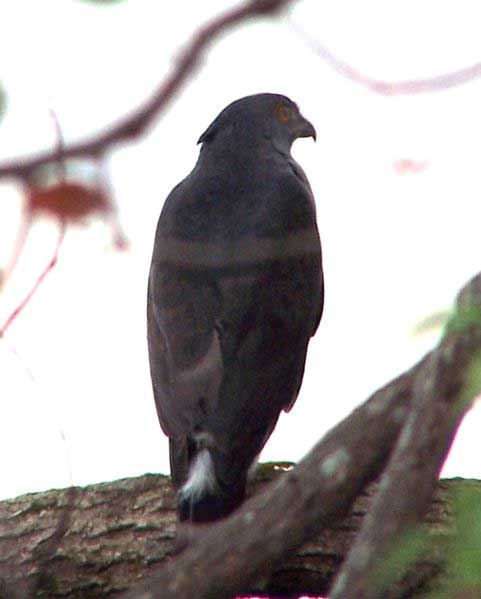
Accipiter trivirgatus (*)
Superregnum: Eukaryota
Regnum: Animalia
Subregnum: Eumetazoa
Cladus: Bilateria
Cladus: Nephrozoa
Superphylum: Deuterostomia
Phylum: Chordata
Cladus: Craniata
Subphylum: Vertebrata
Infraphylum: Gnathostomata
Superclassis: Tetrapoda
Cladus: Reptiliomorpha
Cladus: Amniota
Classis: Reptilia
Cladus: Eureptilia
Cladus: Romeriida
Subclassis: Diapsida
Cladus: Sauria
Infraclassis: Archosauromorpha
Cladus: Crurotarsi
Divisio: Archosauria
Subsectio: Ornithodira
Subtaxon: Dinosauromorpha
Cladus: Dinosauria
Ordo: Saurischia
Cladus: Theropoda
Cladus: Neotheropoda
Infraclassis: Aves
Cladus: Euavialae
Cladus: Avebrevicauda
Cladus: Pygostylia
Cladus: Ornithothoraces
Cladus: Euornithes
Cladus: Ornithuromorpha
Cladus: Ornithurae
Cladus: Carinatae
Parvclassis: Neornithes
Cohors: Neognathae
Ordo: Accipitriformes
Familia: Accipitridae
Genus: Accipiter
Species: Accipiter trivirgatus
Subspecies: A. t. castroi - A. t. extimus - A. t. formosae - A. t. indicus - A. t. javanicus - A. t. layardi - A. t. microstictus - A. t. niasensis - A. t. palawanus - A. t. peninsulae - A. t. trivirgatus
Name
Accipiter trivirgatus (Temminck, 1824)
References
Nouveau recueil de planches coloriées d'oiseaux livr.51 pl.303
Vernacular names
čeština: Jestřáb chocholatý
English: Crested Goshawk
español: Gavilán moñudo
français: Autour huppé
polski: Krogulec czubaty
Türkçe: Tepeli çakır kuşu
粵語: 鳳頭鷹
中文: 凤头鹰
The crested goshawk (Accipiter trivirgatus) is a bird of prey from tropical Asia. It is related to other diurnal raptors such as eagles, buzzards (or buteos) and harriers, and thus placed in the family Accipitridae.[2]
Adults are plain dark grey-brown above. Note the crest.
Description
This raptor has short broad wings and a long tail, both adaptations to manoeuvring through trees. It is 30–46 cm in length, with the female much larger than the male. The larger size and a short crest, clearly visible in profile, are the best distinctions from its relative, the besra (A. virgatus).[2]
The male has a dark brown crown, grey head sides and black moustachial and throat stripes. The pale underparts are patterned with rufous streaks on the breast and bars on the belly. The larger female has a browner head and brown underpart streaks and bars. The juvenile has pale fringes to its head feathers, and the underpart background colour is buff rather than white.[2]
The flight is a characteristic "slow flap, slow flap, straight glide", similar to other Accipiter species such as the northern goshawk (A. gentilis).[2]
Range and ecology
The crested goshawk breeds in southern Asia, from India and Sri Lanka to southern China, Indonesia, Taiwan, and the Philippines. It is primarily a lowland bird, and an all-year resident. Even in upland habitat it is resident in winter, for example in the Himalayas foothills of Bhutan or in Sal (Shorea robusta) forest in India's Dehradun district. In these lands at the northern end of its range, it is generally very rare however. Essentially it is limited to tropical and warm subtropical areas.[3] In Malaysia and Singapore there is increasing evidence of this species adapting to life in urban centres. [4]
Like its relatives, this secretive forest bird hunts birds, mammals and reptiles in woodland, relying on surprise as it flies from a perch to catch its prey unaware. It builds a stick nest in a tree and lays two or three eggs.[2]
The ischnoceran louse Degeeriella storeri is a parasite of this bird; it is not yet known from any other host species. On the other hand, Kurodaia fulvofasciata, an amblyceran louse parasitizing the crested goshawk, is widely found on birds of prey throughout the Holarctic.[5]
In Hong Kong, A. trivirgatus is a protected species under Wild Animals Protection Ordinance Cap 170. It can be found in Kam Shan Country Park.
Taxonomy
The crested goshawk includes the following recognized subspecies:[6]
A. t. indicus (Hodgson, 1836)
A. t. formosae - Mayr, 1949
A. t. peninsulae - Koelz, 1949
A. t. layardi (Whistler, 1936)
A. t. trivirgatus (Temminck, 1824)
A. t. niasensis - Mayr, 1949
A. t. javanicus - Mayr, 1949
A. t. microstictus - Mayr, 1949
A. t. palawanus - Mayr, 1949
A. t. castroi - Manuel & Gilliard, 1952
A. t. extimus - Mayr, 1945
Footnotes
BirdLife International (2016). "Accipiter trivirgatus". IUCN Red List of Threatened Species. 2016: e.T22695462A93510676. doi:10.2305/IUCN.UK.2016-3.RLTS.T22695462A93510676.en. Retrieved 12 November 2021.
Grimmett et al. (1999)
Grimmett et al. (1999), Inskipp et al. (2000), Singh (2002)
Shepherd (2018)
Elbel & Price (1973), Dalgleish (2003)
Gill F, D Donsker & P Rasmussen (Eds). 2020. IOC World Bird List (v10.2). doi : 10.14344/IOC.ML.10.2.
References
Dalgleish, R.C. (ed.) (2003): Birds and their associated Chewing Lice: Accipitridae. Version of 2003-AUG-30. Retrieved 2009-JUN-23.
Elbel, Robert E. & Price, Roger D. (1973): Three new Oriental and New Guinean Degeeriella (Mallophaga: Philopteridae). Pacific Insects 15(1) : 95-101. PDF fulltext
Grimmett, Richard; Inskipp, Carol, Inskipp, Tim & Byers, Clive (1999): Birds of India, Pakistan, Nepal, Bangladesh, Bhutan, Sri Lanka, and the Maldives. Princeton University Press, Princeton, N.J.. ISBN 0-691-04910-6
Inskipp, Carol; Inskipp, Tim & Sherub (2000): The ornithological importance of Thrumshingla National Park, Bhutan. Forktail 14: 147–162. PDF fulltext
Singh, A.P. (2002): New and significant records from Dehra Dun valley, lower Garhwal Himalayas, India. Forktail 18: 151–153. PDF fulltext
Shepherd, C. R. (2018). Crested Goshawk Accipiter trivirgatus may adapt well to life in urban areas across its range in Asia. BirdingASIA 29: 34–35.
Retrieved from "http://en.wikipedia.org/"
All text is available under the terms of the GNU Free Documentation License

